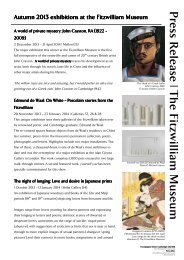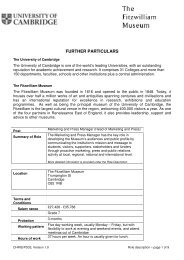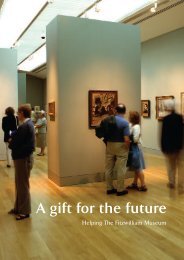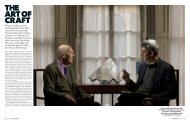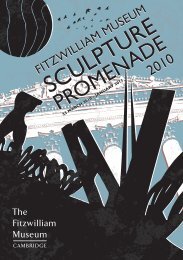Something Different: A pilot study evaluating family outreach ...
Something Different: A pilot study evaluating family outreach ...
Something Different: A pilot study evaluating family outreach ...
You also want an ePaper? Increase the reach of your titles
YUMPU automatically turns print PDFs into web optimized ePapers that Google loves.
<strong>Something</strong> <strong>Different</strong> - Page 45 of 47<br />
Fitzwilliam. Nevertheless, it is clear that this approach is reaching individuals who would<br />
otherwise not be engaged by the cultural sector at all.<br />
Implications for future programme development<br />
O’Neill (2002, p. 35) argues that “managing the context in which individuals<br />
encounter aesthetically charged objects so that individuals can have positive rather than<br />
negative experiences is the ethical responsibility of art museum curators”. However,<br />
delivering a positive experience for “first-time visitors to art museums, for whom<br />
[potentially] none of the works make sense” (O'Neill, 2002, p. 35) is not a simple or<br />
straightforward task, particularly for socially excluded young mothers with very young<br />
children. The positive outcomes achieved by the Fitzwilliam Museum <strong>outreach</strong> programme<br />
required a significant commitment of time and resources. In addition to the education officer,<br />
the activity required the support of two education assistants based in the studio and the<br />
gatekeeper who came with the group. Also, relationship building with the gatekeeper at the<br />
community centre occurred over an extended period of time and was a crucial pre-requisite<br />
for the success of this <strong>outreach</strong> activity.<br />
Evaluating this <strong>outreach</strong> activity was likewise time and resource-intensive. To<br />
conduct qualitative data collection and analysis of this kind in a systematic and valid manner<br />
requires substantial training and experience. In this case, a social scientist was working parttime<br />
on the project over a six-month period, with support from practitioners at the museum, a<br />
professional transcription service and a second social scientist to assist in the observations<br />
and interviews on the days of the visits. To be sure, “evaluation [...], internal or external,<br />
requires commitment and energy” (Galloway & Stanley, 2004, p. 127). These resource<br />
intensive aspects of moving beyond the traditional end-of-session feedback form must be<br />
taken into account in the future design of robust systems of evaluation and feedback.<br />
This <strong>pilot</strong> <strong>study</strong> is indicative of the kind of evidence that can be gathered through a<br />
more formal and thorough approach to evaluation. Clearly such an approach faces constraints<br />
in the wider context of the cultural sector, including under-resourcing, perceptions of data<br />
collection as an instrumental ‘chore’, assumptions that participants would view the research<br />
as intrusive, an ad hoc- rather than systematic- approach to taking on thorough evaluation<br />
activities (see Reeves, 2002, p. 34). However, with the potential for increasing interest in<br />
demonstrating value from within the arts sector (cf. Reeves, 2002, p. 34) meeting a<br />
longstanding interest in evidence from funders and others outside the cultural field, such<br />
constraints may be giving way to some extent.<br />
Conclusion<br />
A large-scale Europe-wide <strong>study</strong> of art museum visitors conducted forty years ago identified<br />
a number of barriers to inclusion, based primarily on class and education level (Bourdieu &<br />
Darbel, 1991/1969). Although her work is not empirical, Duncan (1995) draws on Bourdieu<br />
and Darbel’s arguments and goes even further in arguing that art museums are “engines of<br />
ideology” (p. 3) designed to serve the interests of the state, city, consumerism and patriarchy.<br />
Such negative conclusions about art museums are indicative of a persistent suspicion that



